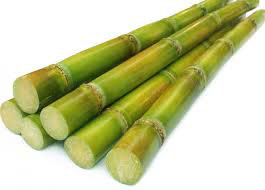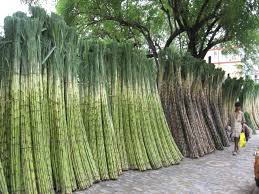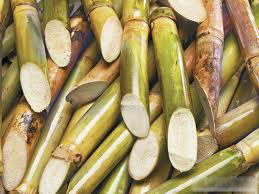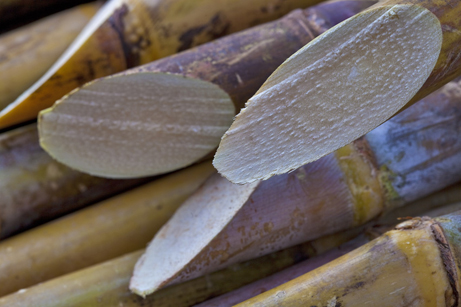
Fresh cut canes. Cane sugar is produced by extracting and refining the juice from the canes.

Harvested canes. It takes about 10 kg of canes to produce 1 kg of cane sugar Icumsa 45, which is the best quality cane sugar.
Cane
Sugar Cane is any of several species of tall perennial true grasses of the genus Saccharum, tribe Andropogoneae, native to the warm temperate to tropical regions of South Asia, and used for sugar production. They have stout jointed fibrous stalks that are rich in sugar, and measure two to six metres (6 to 19 feet) tall. All sugar cane species interbreed and the major commercial cultivars are complex hybrids.
Sugarcane belongs to the grass family (Poaceae), an economically important seed plant family that includes maize, wheat, rice, and sorghum and many forage crops. The main product of sugarcane is sucrose, which accumulates in the stalk internodes. Sucrose, extracted and purified in specialized mill factories, is used as raw material in human food industries or is fermented to produce ethanol. Ethanol is produced on a large scale by the Brazilian sugarcane industry.
Sugarcane is the world's largest crop. In 2010, FAO estimates it was cultivated on about 23.8 million hectares, in more than 90 countries, with a worldwide harvest of 1.69 billion tons. Brazil was the largest producer of sugar cane in the world. The next five major producers, in decreasing amounts of production, were India, China, Thailand, Pakistan and Mexico.
The world demand for sugar is the primary driver of sugarcane agriculture. Cane accounts for 80% of sugar produced; most of the rest is made from sugar beets. Sugarcane predominantly grows in the tropical and subtropical regions, and sugar beet predominantly grows in colder temperate regions of the world.
Other than sugar, products derived from sugarcane include falernum, molasses, rum, cachaça (a traditional spirit from Brazil), bagasse and ethanol. In some regions, people use sugarcane reeds to make pens, mats, screens, and thatch.
Geography
In India, between the sixth and fourth centuries BC, the Persians, followed by the Greeks, discovered the famous "reeds that produce honey without bees". They adopted and then spread sugar and sugarcane agriculture. A few merchants began to trade in sugar—a luxury and an expensive spice until the 18th century. Before the 18th century, cultivation of sugar cane was largely confined to India. Sugarcane plantations, like cotton farms, were a major driver of large human migrations in the 19th and early 20th century, influencing the ethnic mix, political conflicts and cultural evolution of various Caribbean, South American, Indian Ocean and Pacific island nations.
Brazilian sugar is perhaps the most well known type of sugar in the world. As the biggest sugar exporteron the planet, Brazil produces around thirty million tons of sugar every year, and exports two thirds of that to various countries.
Brazilian sugar is grown in two major regions in Brazil, the larger of these is the Sao Paulo region. Located in the center south of the country, it is known for its vast fertile plains, much of which have been turned over to sugar cane production over the past decades as sugar has become an increasingly viable crop, and as interest in sugar ethanol as a form of alternate fuel has also grown.
The other major growing region is in the northern states of Pernambuco and Algolas. Though these states are much less fertile and boast rugged terrain which is not nearly as well suited to the cultivation of sugar cane, they are the historical home of sugar production in Brazil. They are also the main regions of expansion, as the Sao Paulo region recently cut permits for new sugar mills in that jurisdiction due to environmental concerns, leaving would be developers to seek other regions in which to build their mills.
Global demand for sugar has continued to increase over the years, with population growth and the growing popularity of the Western style diet accounting for much of this growth. Production has also increased in many countries, and India in particular is now a solid rival to Brazil in the production stakes, though its exports are significantly lower than Brazil’s.
Brazil
The great majority of Brazil’s sugar exports are in the form of VHP raw sugar, a raw sugar product that has undergone some processing to increase its polarity. VHP raw sugar contains no less than 99.4% sucrose, is a light brown color, and is in great demand by refineries around the world. VHP raw sugar is a Brazilian invention, created in 1993 as an answer to the inherent inefficiency of carting large amounts of raw sugar around the world only to lose a great deal of it to the refining process due to the fact that so much of it was made up of liquids and contaminants. Refineries soon saw the benefits to using a high sucrose raw material instead of traditional raw sugar, and the Brazilian sugar industry went from strength to strength after its invention.
Brazil’s domination of the global sugar market has arisen through both agricultural prowess, technical innovation, and an emphasis on research and development. Though other countries, such as India, are now beginning to approach Brazil in production levels, they still lag behind the sugar giant in terms of growing practices, production quality, and biochemical prowess.
Brazil has always placed great importance on researching sugar, and even went so far as to sequence the sugar cane genome. As a result of this, and other related endeavors, there are now hundreds of different strains of sugar cane in Brazil. These strains have been designed for greater sucrose yield, for more successive generations of growth (sugar cane is usually left to grow for several generations, being harvested each season by cutting off the cane, but leaving the roots to grow again and again in successive seasons until the sucrose content of the newly grown cane dips below acceptable levels, or the roots become too damaged to grow healthy sugar cane, at which point the field is tilled and fresh cane sown), and to grow in difficult conditions.
Equal attention has been paid to the physical processes associated with milling sugar cane and refining sugar. Most Brazilian sugar mills have efficiency teams whose job it is to streamline and economize all processes in the plant. Recycling is also a high priority, with the sugar cane fiber often burned to power the facility. So efficient are Brazilian mills that they often manage to sell power onto the national grid because the burning of the bagasse (a name given to the fibrous part of the sugar cane discarded after crushing) provides more than enough energy to power the plant.
History
A native of tropical countries such as India and New Guinea, sugar cane developed in several different nations simultaneously, with different strains of sugar cane being successful in different regions. There is some argument over where sugar cane was first cultivated intentionally for the purposes of producing sugar, however there are records of sugar in India as far back as 3000 BCE.
Sugar cane traveled along with Buddhism from India to China in the 7th century CE, and the Chinese quickly became adept at cultivating sugar cane and making sugar. For a very long time, sugar cane, and sugar were known only in the eastern countries. Sugar cane was taken to the Middle East and Africa by traveling Arabian people, but it was not until the Crusades that this miraculous plant became widely known in the West. At first, both sugar cane and sugar were a rare commodity for westerners, and at one stage it was even said that sugar was more expensive than gold in London.
With the discovery of sugar cane by western populations, sugar cane plantations were eventually established in many British colonies, particularly Carribean ones. African slaves were used to work the plantations and the boiling houses in which sugar cane was processed into sugar.
The Dutch bought sugar cane to Brazil, and also used African slaves to man the first plantations and boiling houses, which were established in the northern regions of the country. Today Brazil is the world’s largest producer of sugar cane and sugar cane products, and many plantations, mills, and refineries are still operating in the northern regions of Brazil, though nowadays the labor is, of course, paid.
Growing
Sugar cane is planted by hand, not from seed, but from cuttings called “setts”. These setts are half a meter to one and a half meters long, and have several buds growing along their lengths. When planted horizontally in furrows, watered and fertilized, these setts send up shoots within a few weeks. Each of the shoots is a new stalk of sugar cane.
Sugar cane requires a great deal of water to grow well, and does not take kindly to cold temperatures, infertile soils, or harsh chemicals. Though hardier strains have been developed, ideal growing conditions are flat, fertile soil with plenty of nutrients in a tropical or sub tropical climate.
If the setts are not disturbed during harvesting, and are well maintained, they can continue to grow for up to twelve harvests, though three to five is a more typical number. After the first few harvests, damage and old age begins to take its toll, and the new shoots are not as healthy or as rich in sucrose as the ones before them. It is at this stage that the whole field will often be ploughed, and new setts planted.
Harvesting
When it comes time to harvest the sugar cane, one of two methods can be used. In some cases, human laborers work the fields, cutting the sugar cane off low to the ground and bundling the stalks up for their trip to the sugar mill. The work is back breaking and difficult, and good workers are worth their weight in gold to owners of sugar cane crops. Because sugar cane regrows after it is harvested, it is essential that the roots not be damaged when the cane is harvested. Clumsy workers can quickly destroy an entire field of sugar cane, costing the owner thousands of dollars or more.
When human labor is used to harvest sugar cane, it is not uncommon for the field to first be burnt. The flames quickly consume excess foliage, leaving just the stalks ready for harvesting. This is a safety measure for the workers, as it kills any poisonous snakes that may have been living in the field and it also makes it easier for the harvesters to see what they are doing without the visual impediment of dense leafy foliage to contend with, which cuts down on accidents considerably.
Another option is to harvest sugar cane using a machine. Large mechanical harvesters can travel up and down a field, harvesting the cane, stripping it of unwanted leaves, and bundling it tidily in the back of the harvester. Naturally there are some obvious advantages to this method, only one labourer needs to be paid, the harvester does not require meals or a place to sleep at night, and will not need a break every hour or two.
Fortunately for labourers who in many countries depend on the yearly harvesting season to make money, mechanical harvesters also come with their fair share of problems. To begin with, they are not very well suited to operation on uneven surfaces. Fields need to be flat in order for a mechanical harvester to be truly effective. Also, mechanical harvesters have been known to cause damage to the underlying roots by either harvesting the cane too roughly, or by crushing them under their heavy tires. Machines also require petrol, which is becoming an increasingly pricey commodity.

Cut canes. The raw juice is extracted from the canes.

Canes. The juicy inner of the canes is almost visible by the eye.
Processing
After harvesting, sugar cane is processed at the sugar mill by washing the stalks, then shredding them with very sharp blades. Once the stalks are shredded, they are put through rollers to squeeze the juice out of them. What emerges from this process is a dark brown high sucrose juice commonly known as “raw juice”, and the dry sugar cane fiber known as ‘bagasse’.
Sugar cane is a deceptively versatile material, useful for making a wide range of products. Sugar, is of course an obvious one, and sugar ethanol has been growing steadily in popularity as a global fuel crisis sends nations looking for ways to wean themselves of a dependency on oil.
Bagasse
For a long time, Bagasse was simply discarded and burned in the fields as a waste product. Nowadays bagasse finds a plethora of applications, both in the sugar mill and out of it. Many mills now burn the bagasse resulting from their sugar cane milling operations in the mill itself, and use the resulting heat to generate electricity which powers the mill. So much energy can be made in this fashion that it is not uncommon for there to be a surplus of power, which is then very often sold onto the national grid, making the sugar mill incredibly energy efficient.
Bagasse is also used as charcoal. Charcoaled bagasse is a clean burning product that provides a great deal of heat at a relatively low cost. It is easily stored, and can keep for much longer than traditional charcoal briquettes.
Some manufacturers are exploring uses of Bagasse in disposable tableware. When pressed into cups and plates, Bagasse makes for a strong, relatively durable product which can stand heat and moisture, and which biodegrades entirely in just a few months, making it an obvious choice for anyone concerned with the impact of traditional disposable dinnerware materials such as plastic and polystyrene. Bagasse tableware is also entirely freezer and microwave safe, making it much more convenient and versatile than traditional materials.
Molasses
Traditionally, sugarcane processing requires two stages. Mills extract raw sugar from freshly harvested cane, and sometimes bleach it to make "mill white" sugar for local consumption. Refineries, often located nearer to consumers in North America, Europe, and Japan, then produce refined white sugar, which is 99 percent sucrose. These two stages are slowly merging. Increasing affluence in the sugar-producing tropics increased demand for refined sugar products, driving a trend toward combined milling and refining.
The raw sugar juice is being refined by extrating the sugar from the juice. It takes several cycles to extract all sugars from the juide. In each step the byproduct is called "molasses". For each cycle the sugar content gets lower and lower in the molasses.
Molasses is used in everything from animal feed to health supplements. It has a sweet/bitter taste, and is full of healthy minerals such as calcium, potassium, magnesium, and iron. There are many different grades of molasses, some suitable only for animal feed, and others quite suitable for human consumption.
Statistics
Top ten producers of canes — 2011
| Country | Production (TMT) |
|---|---|
| Brazil | 734 000 |
| India | 342 382 |
| People's Republic of China | 115 124 |
| Thailand | 95 950 |
| Pakistan | 55 309 |
| Mexico | 49 735 |
| Philippines | 34 000 |
| United States | 26 656 |
| Australia | 25 182 |
| Argentina | 25 000 |
| World | 1 794 359 |
World production of canes in 1000 metric tones. It takes about 10 tons of cane to produce 1 ton of white refined cane sugar. (Source: Food And Agricultural Organization of United Nations, Economic And Social Department, The Statistical Division.)

